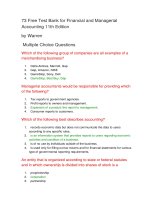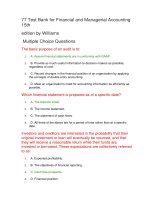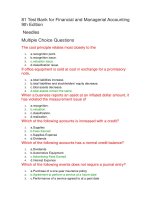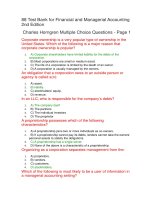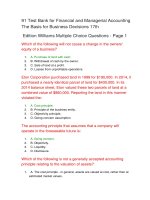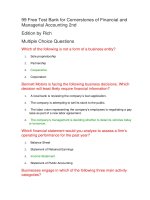Financial and managerial accounting 2nd kimel kieso willey chapter 22
Bạn đang xem bản rút gọn của tài liệu. Xem và tải ngay bản đầy đủ của tài liệu tại đây (3.01 MB, 73 trang )
22-1
22
Pricing
Learning Objectives
1
Compute a target cost when the market determines a product price.
2
Compute a target selling price using cost-plus pricing.
3
4
22-2
Use time-and-material pricing to determine the cost of services
provided.
Determine a transfer price using the negotiated, cost-based, and market-based approaches.
LEARNING
OBJECTIVE
1
Compute a target cost when the market determines a product price.
The price of a good or service is affected by many factors.
Illustration 22-1
Pricing factors
Regardless of the factors involved, the price must cover the costs of the good or service as well as earn a
reasonable profit.
22-3
LO 1
Pricing Goods for External Sales
The price of a good or service is affected by many factors.
Company must have a good understanding of market forces.
Where products are not easily differentiated from competitor goods, prices are not set by the
company, but rather by the laws of supply and demand – such companies are called price takers.
Where products are unique or clearly distinguishable from competitor goods, prices are set by the
company.
22-4
LO 1
Management Insight
The Only Game in Town?
Pricing plays a critical role in corporate strategy. For example, almost 50% of tablet computer users say that they use them to read
newspapers and magazines. And since Apple’s iPad tablet computer at one time represented 75% of the tablets being sold, Apple
felt like it had the newspaper and magazine publishers right where it wanted them. So it decided to charge the publishers a fee of
30% of subscription revenue for subscriptions sold at Apple’s App Store. Publishers were outraged, but it didn’t take long for
somebody to come to their rescue. Within 1 day of Apple’s announcement, Google announced that it would only charge a fee of
about 10% of subscription revenue for users of its Android system. That might at least partially explain why Sports Illustrated
provided an app to run on Android tablets before it provided one for iPads, even though at that time Android tablets only had a
small share of the market.
Source: Martin Peers, “Apple Risks App-lash on iPad,” Wall Street
Journal Online (February 17, 2011).
22-5
LO 1
Target Costing
22-6
Laws of supply and demand significantly affect product price.
To earn a profit, companies must focus on controlling costs.
Requires setting a target cost that will provide the company’s desired profit.
LO 1
Target Costing
Target cost: Cost that provides the desired profit when the market determines a product’s price.
Illustration 22-2
Target cost as related to price and
profit
22-7
If a company can produce its product for the target cost or less, it will meet its profit goal.
LO 1
Target Costing
First, company should identify its market niche where it wants to compete.
Second, company conducts market research to determine the target price – the price the company
believes will place it in the optimal position for the target consumers.
22-8
Third, company determines its target cost by setting a desired profit.
Last, company assembles a team to develop a product to meet the company’s goals.
LO 1
Management Insight
Wal-Mart Stores, Inc.
Wal-Mart Says the Price Is Too High
“And the price should be $19 per pair of jeans instead of $23,” said the retailer Wal-Mart Stores, Inc. to jean maker Levi Strauss.
What happened to Levi Strauss is what happens to many manufacturers who deal with Wal-Mart. Wal-Mart often sets the price,
and the manufacturer has to figure out how to make a profit, given that price. In Levi Strauss’s case, it revamped its distribution
and production to serve Wal-Mart and improve its overall record of timely deliveries. Producing a season of new jeans styles, from
conception to store shelves, used to take Levi 12 to 15 months. Today, it takes just 10 months for Levi Strauss signature jeans; for
regular Levi’s, the time is down to 7 1/2 months. As the chief executive of Levi Strauss noted, “We had to change people and
practice. It’s been somewhat of a D-Day invasion approach.”
Source: “In Bow to Retailers’ New Clout, Levi Strauss Makes Alterations,” Wall Street Journal (June 17, 2004), p A1.
22-9
LO 1
1
Target Costing
Fine Line Phones is considering introducing a fashion cover for its phones. Market research indicates that 200,000
units can be sold if the price is no more than $20. If Fine Line decides to produce the covers, it will need to invest
$1,000,000 in new production equipment. Fine Line requires a minimum rate of return of 25% on all investments.
Determine the target cost per unit for the cover.
The desired profit for this new product line is
$1,000,000 x 25% = $250,000
Each cover must result in profit of $250,000 ÷ 200,000 units = $1.25
Market price
$20
22-10
Desired profit
-
$1.25
Target cost per unit
=
$18.75 per unit
LO 1
Target Costing
Question
Target cost related to price and profit means that:
22-11
a.
Cost and desired profit must be determined before selling price.
b.
Cost and selling price must be determined before desired profit.
c.
Price and desired profit must be determined before costs.
d.
Costs can be achieved only if the company is at full capacity.
LO 1
LEARNING
2
OBJECTIVE
Compute a target selling price using cost-plus pricing.
Cost-Plus Pricing
In an environment with little or no competition, a company may have to set its own price.
When a company sets price, the price is normally a function of product cost: cost-plus pricing.
Approach requires establishing a cost base and adding a markup to determine a target selling
price.
Illustration 22-4
Cost-plus pricing formula
22-12
LO 2
Cost-Plus Pricing
In determining the proper markup, a company must consider competitive and market conditions.
Size of the markup (the “plus”) depends on the desired return on investment for the product:
ROI = net income ÷ invested assets
Illustration 22-3
Relation of markup to cost
and selling price
22-13
LO 2
Cost-Plus Pricing
Illustration: Thinkmore Products, Inc. is in the process of setting a selling price on its new video
camera pen. It is a functioning pen that will record up to 2 hours of audio and video. The per unit
variable cost estimates for the new video camera pen are as follows.
Illustration 22-5
22-14
Variable cost per unit
LO 2
Cost-Plus Pricing
In addition, Thinkmore has the following fixed costs per unit at a budgeted sales volume of 10,000 units.
Illustration 22-6
Fixed cost per unit, 10,000 units
22-15
LO 2
Cost-Plus Pricing
Thinkmore has decided to price its new video camera pen to earn a 20% return on its investment (ROI)
of $2,000,000.
Markup = 20% ROI of $2,000,000
Expected ROI = $400,000 ÷ 10,000 units = $40
Markup price per unit
=
Illustration 22-8
Computation of selling price,
10,000 units
22-16
LO 2
Cost-Plus Pricing
Use markup on cost to set a selling price:
Compute the markup percentage to achieve a desired ROI of $20 per unit:
Illustration 22-9
Computation of markup percentage
Illustration 22-10
22-17
Compute the target selling price:
Computation of selling price—markup
approach
LO 2
Cost-Plus Pricing
LIMITATIONS OF COST-PLUS PRICING
Advantage of cost-plus pricing: Easy to compute.
Disadvantages:
►
Does not consider demand side:
►
Fixed cost per unit changes with change in sales volume:
22-18
Will the customer pay the price?
At lower sales volume, company must charge higher price to meet desired ROI.
LO 2
LIMITATIONS OF COST-PLUS PRICING
Illustration: If budgeted sales volume for Thinkmore’s Products was 5,000 instead of 10,000, Thinkmore’s
variable cost per unit would remain the same. However, the fixed cost per unit would change as follows.
Illustration 22-11
Fixed cost per unit, 5,000 units
Thinkmore's desired 20% ROI now results in a $80 ROI per unit [(20% x $2,000,000) ÷ 5,000].
22-19
LO 2
LIMITATIONS OF COST-PLUS PRICING
Thinkmore computes the selling price at 5,000 units as follows.
Illustration 22-12
Computation of selling price, 5,000 units
At 5,000 units, how much would Thinkmore mark up its total unit costs to earn a desired ROI of $80 per unit.
22-20
LO 2
Variable-Cost Pricing
Alternative pricing approach:
Simply add a markup to variable costs.
Avoids the problem of uncertain cost information related to fixed-cost-per-unit computations.
Helpful in pricing special orders or when excess capacity exists.
Major disadvantage is that managers may set the price too low and fail to cover fixed costs.
22-21
LO 2
Cost-Plus Pricing
Question
Cost-plus pricing means that:
22-22
a.
Selling price = variable cost + (markup percentage + variable cost).
b.
Selling price = cost + (markup percentage X cost).
c.
Selling price = manufacturing cost + (markup percentage + manufacturing cost).
d.
Selling price = fixed cost + (markup percentage X fixed cost).
LO 2
Management Insight
Parker Hannifin
At Least it Was Simple
For nearly 90 years, Parker Hannifin used the same simple approach to price its industrial parts. It calculated the production cost, then
added on a percentage of the cost (about 35%) to arrive at the price. It didn’t matter if a product was a premium product or a standard
product. And if Parker reduced its production costs, it then also cut the price for the product. The problem with this approach was that it
made it difficult for the company to ever substantially increase its profit margins. So the company’s CEO decided to break with tradition
and implement strategic pricing schemes similar to those used by retailers. It determined that for about a third of its products, it had a
competitive advantage that would allow it to charge a higher markup. For example, there might be limited competition for the product, or
its product might be of higher quality, or it might have the ability to produce a product faster. The company determined that the price
increases raised net income by $200 million—not bad considering that net income was $130 million before the price increases.
Source: Timothy Aeppel, “Changing the Formula: Seeking Perfect Prices, CEO Tears Up the Rules,” Wall Street Journal Online (March 27, 2007).
22-23
LO 2
2
Target Selling Price
Air Corporation produces air purifiers. The following per unit cost information is available: direct materials $16,
direct labor $18, variable manufacturing overhead $11, variable selling and administrative expenses $6. Fixed
selling and administrative expenses are $50,000, and fixed manufacturing overhead is $150,000. Using a
45% markup percentage on total per unit cost and assuming 10,000 units, compute the target selling price.
22-24
LO 2
2
Target Selling Price
Using a 45% markup percentage on total per unit cost and assuming 10,000 units, compute the target selling
price.
22-25
LO 2


